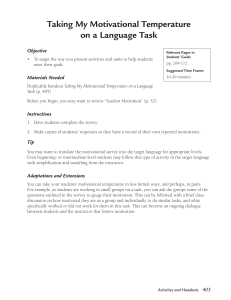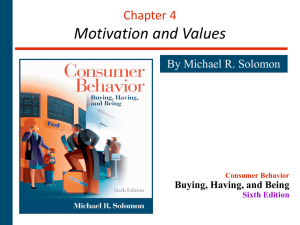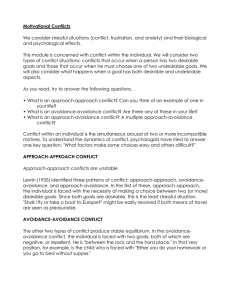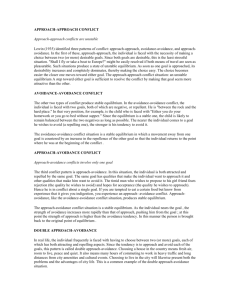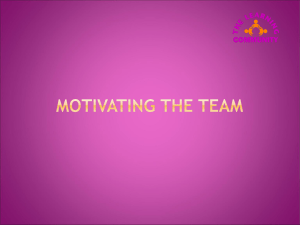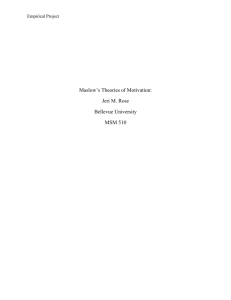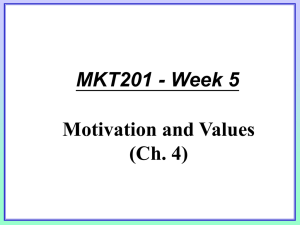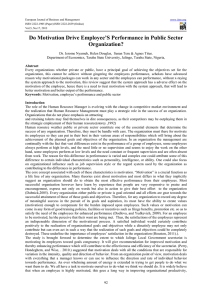Review4
advertisement
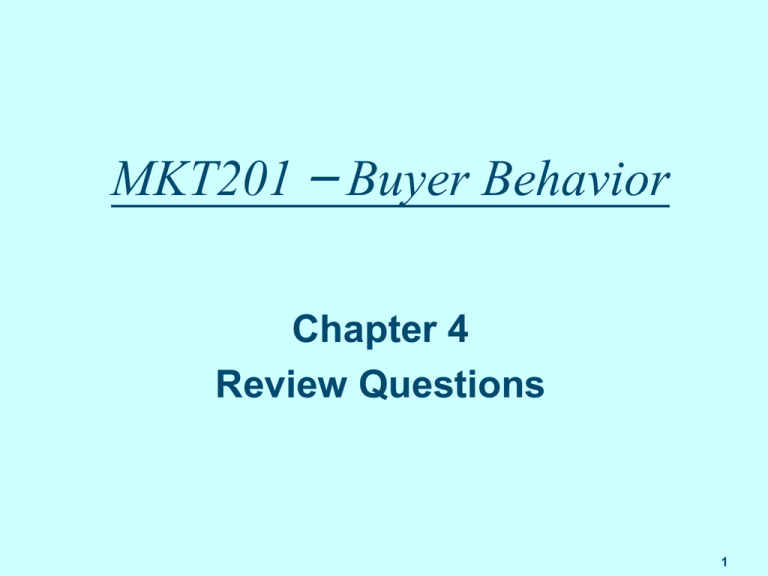
MKT201 – Buyer Behavior Chapter 4 Review Questions 1 Motivation & Values: studies why consumers do what they do Motivation 1. The Motivation Process – need, want, drive & goal 2. Motivational Strength 3. Motivational Direction (1) types of needs (2) motivational conflicts (3) classifying consumer needs 4. Consumer Involvement & Measuring Involvement Values 5. Consumer Values 2 1. A customer can either afford to buy a new mp3 device or a new Xbox 360 game station, but not both. After purchase, regardless of the choice, the customer will probably find reasons to feel good about the selection. Why? a. b. c. d. Because of cognitive dissonance the customer will be motivated to resolve the conflict by creating or emphasizing positive aspects of the purchase and the negative aspects of the product not chosen. Because of a need for achievement, the customer will be motivated to want the product that is the most expressive of power and status. People always feel good about buying a product after they begin using it. The typical reaction to an approach-avoidance conflict is to be motivated to approach only the positive aspect of the conflict, thus ensuring a satisfactory resolution of the conflict. 3 2. Consumption at the extreme low end of the involvement continuum is characterized by ________ when decisions are made out of habit. a. b. c. d. inertia flow formation fuzzy marketing 4 3. Some values are universal. The way a culture arranges these values in order of importance is referred to as ________. a. b. c. d. differential values an acculturated importance set a value system product mining 5 4. Jake feels a hunger growing in his stomach. The more he feels the hunger, the more he wishes lunchtime would hurry and arrive. He is already planning what he will eat and how good it will taste. Which of the following processes most accurately describes what Jake is going through? a. b. c. d. The goal process The directionality process The motivation process The involvement process 6 5. Seth Hernandez is sitting in a class that precedes the lunch hour. His stomach begins to rumble and grumble. Instead of thinking about the day's lecture, Seth begins to think about lunch and his choice of places to eat. He even begins to narrow down the selection of foods that he might want for lunch. Because Seth is focusing on biological needs that are at present unfulfilled and have produced what might be thought of as an unpleasant state of arousal, he is experiencing what researchers call ________. a. b. c. d. fact-and–find theory drive theory emotional theory cognitive theory 7 6. Jill is traveling over the school break. She doesn't want to spend a lot of money on the airfare. Even though it took more time, she went online to get tickets instead of going to a travel agent. What theory of motivation best explains Jill's behavior? a. Drive theory b. Instinct theory c. Expectancy theory d. Need-versus-want theory 8 7. An automobile company emphasizes such qualities as high miles per gallon of gasoline, an excellent rating in safety, and high resale value of its product in its advertising. The company is trying to appeal to which of the following types of consumer needs? a. b. c. d. Psychogenic needs Biogenic needs Hedonic needs Utilitarian needs 9 8. What is the most important thing that a marketing practitioner can learn from Maslow's theory? a. Safety needs are more important than social needs. b. Maslow's hierarchy scheme of needs has been found to be universal and apply equally in all cultures. c. Maslow's theory is theoretical and has been very difficult to actually apply in practice. d. Most people must first have their basic needs met before they will be motivated by higher needs. 10 9. The local Harley-Davidson motorcycle outlet has special events on Saturday mornings. Vintage bikes are shown, food is served, and some people travel more than a 100 miles on their Harleys to be there almost every Saturday morning. This marketing dream is possible because Harley-Davidson has become a ________ product. a. b. c. d. fuzzy cult flow state situational 11 10. Joe was told by his mother that he needed to get a gift for his aunt's birthday. He had only met his aunt once before and hardly knew her. Joe was walking through a mall and saw a candy specialty store. He entered and looked at the selection without much interest. He was about to select a box of chocolates simply because it was cheap when he remembered that his new friend Julie loved chocolate and Joe really liked Julie. He began to inspect each box of chocolates carefully, trying to find evidence of quality. Which type of involvement explains Joe's change of behavior? a. product involvement b. price involvement c. purchase situation involvement d. message involvement 12 Essay Questions: 1. Identify and discuss three general types of motivational conflict. In addition, comment on how these conflicts help to bring about satisfaction of needs. Provide an example of how marketers tailor their marketing communications to fit consumer needs in each of these cases. The three types of motivational conflict are: – Approach-approach conflict—A choice between two desirable alternatives – Approach-avoidance conflict—Involves a choice in which some aspects of the product are positive and others are negative – Avoidance-avoidance conflict—Involves a choice between two negative alternatives Generally, each time the consumer is faced with making choices, the dissonance that is created can potentially keep the consumer from feeling fulfilled in his or her decision. In each case, marketers should provide additional information the consumer can use to justify the choice he or she made: – In approach-approach conflicts, marketing communications should emphasize (a) "no-lose" and/or "win either way" message(s). – In approach-avoidance conflicts, messages should accentuate the positive aspects and either downplay the negative or provide some additional counterbalancing information about the choices. – In avoidance-avoidance conflicts, messages should emphasize the need for making a choice and link it to some other more attractive value held by the consumer. 13 Essay Questions: 2. What is the relationship between a drive, a need, and a want? – A drive is the degree of arousal typically created by a discrepancy between the customer's present state and some ideal state. – A need is what a customer requires to achieve a goal created by a drive. – A want is a manifestation of a need. – As an example, suppose that a student found a new job that required her to be at a certain location at a certain time. The need to earn enough money to take care of her expenses motivated her to obtain the job. She now also has a need to get to work. She wants an Italian scooter to satisfy her need to get to work. 14
